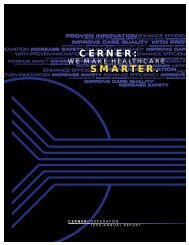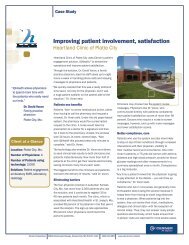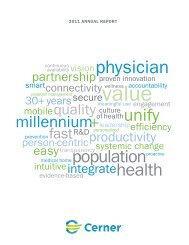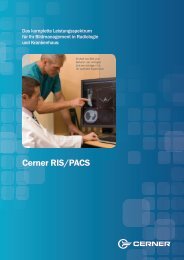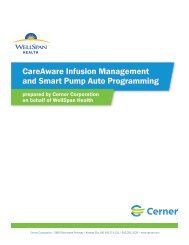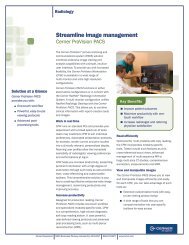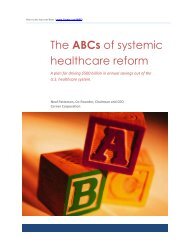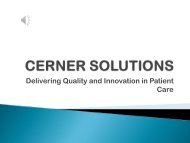The ABCs of systemic healthcare reform - Cerner Corporation
The ABCs of systemic healthcare reform - Cerner Corporation
The ABCs of systemic healthcare reform - Cerner Corporation
- No tags were found...
You also want an ePaper? Increase the reach of your titles
YUMPU automatically turns print PDFs into web optimized ePapers that Google loves.
To <strong>Cerner</strong>’s Shareholders, Clients and Associates:<br />
Every year, this letter provides an opportunity to report <strong>Cerner</strong>’s annual progress and provide updates <strong>of</strong> material events that took<br />
place during the year. On most occasions, I also use this letter to reflect on the major trends we believe have affected our company.<br />
In summary, the year 2008 was one in which <strong>Cerner</strong> delivered solid performance despite a very challenging environment. Below<br />
are highlights <strong>of</strong> <strong>Cerner</strong>’s 2008 performance, with 3-, 5- and 10-year compound annual growth rates for many <strong>of</strong> the financial<br />
metrics included to provide a longer-term perspective.<br />
• Revenue grew 10% to $1.68 billion, with long-term growth rates <strong>of</strong> 13%, 15% and 18%.<br />
• Our operating margin 1 increased 150 basis points to 16.6%, up from 12.6% and 9.3% three and five years ago.<br />
• Net earnings 1 grew 26% to $183 million, with long-term growth rates <strong>of</strong> 29%, 34% and 23%.<br />
• Earnings per share 1 grew 25% to $2.19, with long-term growth rates <strong>of</strong> 26%, 30% and 20%.<br />
• Bookings grew 2% to $1.54 billion, with long-term growth rates <strong>of</strong> 11%, 14%, and 16%. In 2008, 29% <strong>of</strong> bookings came<br />
from clients without a <strong>Cerner</strong> Millennium ® footprint, reflecting strong competitiveness.<br />
• Revenue backlog grew 7% to $3.49 billion, with long-term growth rates <strong>of</strong> 18%, 23% and 22%.<br />
• Cash flow from operations grew 3% to $282 million, with long-term growth rates <strong>of</strong> 7%, 16% and 47%. Free cash flow,<br />
defined as operating cash flow less capital expenditures and capitalized s<strong>of</strong>tware, was an all-time high <strong>of</strong> $104 million, an<br />
$80 million increase from 2007 free cash flow <strong>of</strong> $24 million.<br />
• Despite solid financial results, <strong>Cerner</strong>’s stock price ended the year at $38.45, declining 32% in 2008, which was better than<br />
the broader market (NASDAQ Composite Index and S&P 500 down 41% and 38%, respectively), but still disappointing. <strong>The</strong><br />
3-, 5- and 10- year compound annual growth rates for <strong>Cerner</strong>’s stock are -5%, 15% and 11%, respectively. <strong>The</strong>se returns are<br />
significantly greater than the returns over the same time frames for the NASDAQ Composite Index (-11%, -5%, -3%) and S&P<br />
500 (-10%, -4%, -3%).<br />
Operationally, we had a very productive year creating value for <strong>healthcare</strong> organizations around the globe by implementing new<br />
<strong>Cerner</strong> ® solutions, upgrading existing solutions to the newest releases and improving operational performance. Our suite <strong>of</strong><br />
information solutions and services is the broadest and deepest in <strong>healthcare</strong>, and we have the largest and most diverse group <strong>of</strong><br />
clients, including leading health systems, hospitals, clinics, physician practices, laboratories, pharmacies, home health agencies,<br />
employers and consumers.<br />
1 Operating margin, net earnings and earnings per share reflect adjustments compared to results reported on a Generally Accepted Accounting Principles<br />
(GAAP) basis in our 10-K. Non-GAAP results should not be substituted as a measure <strong>of</strong> our performance but instead should be used along with GAAP results as<br />
a supplemental measure <strong>of</strong> financial performance. Non-GAAP results are used by management along with GAAP results to analyze our business, make strategic<br />
decisions, assess long-term trends on a comparable basis and for management compensation purposes. Please see the appendix to this letter for a reconciliation <strong>of</strong><br />
these items to GAAP results.<br />
1979<br />
1982<br />
1983<br />
1984<br />
1986<br />
1987<br />
Neal Patterson, Paul Gorup,<br />
and Cliff Illig leave Arthur<br />
Andersen & Co. to form their<br />
own company<br />
PathNet ® is installed in<br />
the lab at St. John Medical<br />
Center in Tulsa, Oklahoma<br />
29 associates<br />
<strong>Cerner</strong> secures $1.5 million<br />
venture capital funding<br />
from First Chicago Capital<br />
<strong>Corporation</strong><br />
<strong>Cerner</strong> goes public on<br />
NASDAQ (CERN)<br />
$17 million <strong>of</strong> revenue<br />
149 associates<br />
<strong>Cerner</strong> listed as one <strong>of</strong> Inc.<br />
magazine’s 100 fastestgrowing<br />
companies<br />
6



